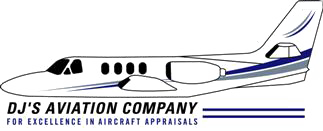Example Appraisal Grading Criteria
Our process for evaluating the value of aircraft utilizes detailed criteria and instructions for the individual appraiser in order to eliminate the subjectivity used by a non-certified aircraft appraiser.
These criteria and instructions, together with comprehensive data bases and proprietary computer software in the hands of highly qualified aviation professional produces the most accurate and objective appraisal possible.
The criteria below are an example of those used by our appraisers in assessing the condition of the exterior paint. Similarly detailed criteria are used for other assessments of the aircraft's condition.
Exterior Paint Grading
- #10 Grading: Condition of the exterior paint is flawless. External painted surfaces have a deep, rich, wet look. There is no pooling, sagging, running, orange peeling, thin areas or over-spray on any painted surfaces. Stripes and numerals are well defined with crisp lines and no irregularities. The paint is of high quality. If a re-paint, all surfaces have been stripped and prepared properly and consistent with the paint manufacturers recommended application procedures. The age of the paint is two years old, or less.
- #9 Grading: Exterior painted surfaces are almost flawless. In almost every aspect the painted surfaces would meet the #10 rating criteria except for minor exceptions. The paint may be over two years old but less than 5 years old if the aircraft is tied down outside or 10 years if old if the aircraft is stored under cover. There may be a very small amount of dust particles in the paint. There may be a few chips in the paint under the fuselage from props slinging pebbles. Paint looks like new and the above discrepancies are only discernible upon very close inspection.
- #8 Grading: Paint has a wet look with a few chipped areas under wings, fuselage and empennage. Leading edges may show first stages of abrasion wear but overall the paint is in very good condition and shows very well within 20 feet.
- #7 Grading: Paint has a good shine with some abrasion wear on leading surfaces but still retaining good coverage. Repainted surfaces or touched up areas are not noticeable. The paint may be new with a limited amount of orange peel, pooling, sags or over-spray. However, painted surfaces are well protected and the aircraft has good eye appear.
- #6 Grading: Paint is beginning to oxidize with evident abrasion wear on leading edges. Paint is in need of a good cleaning and waxing to give it a semi-gloss appearance. If recently painted, there may be pooling, sagging, running or orange peeling and/or significant amount of foreign particles in paint. Accent trim may be of poor quality, but paint overall would be adhering well to surfaces. Overall appearance within 30 feet is fair to good.
- #5 Grading: Paint is oxidizing and there may be numerous areas of chipping on lower surfaces of aircraft. Leading edges show significant signs of abrasion wear, but are protected by paint. Surface corrosion may be apparent on the airframe and will affect paint because the painted surface must be stripped in order to treat the corrosion. Overall appearance is fair within 30 feet.
- #4 Grading: Consistent with all of the characteristics of #5 rating except the aircraft will soon need repainting. Overall appearance is poor to fair and cleaning/waxing will not significantly improve the appearance or protection of the aircraft surfaces.
- #3 Grading: Paint is poor quality, oxidized and shows excessive wear on leading edges and control surfaces. Many chips and scratches are apparent and overall the aircraft needs painting. However, the paint is protecting the aircraft surfaces, but looks poor.
- #2 Grading: Aircraft needs painting. No good points.
- #1 Grading: Aircraft needs painting, and additional preparation of the aircraft surfaces is required before painting. Generally consistent with aircraft having extensive corrosion on surfaces.
These exacting standards are impossible to determine without a physical examination of the aircraft. This is just one of the many standards used for all the different aircraft components.
